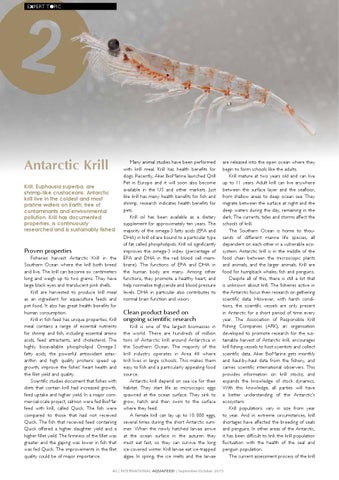EXPERT Tâ—?PIC
Antarctic Krill Krill, Euphausia superba, are shrimp-like crustaceans. Antarctic krill live in the coldest and most pristine waters on Earth, free of contaminants and environmental pollution. Krill has documented properties, is continuously researched and is sustainably fished.
Proven properties
Fisheries harvest Antarctic Krill in the Southern Ocean where the krill both breed and live. The krill can become six centimeters long and weigh up to two grams. They have large black eyes and translucent pink shells. Krill are harvested to produce krill meal as an ingredient for aquaculture feeds and pet food. It also has great health benefits for human consumption. Krill in fish feed has unique properties. Krill meal contains a range of essential nutrients for shrimp and fish, including essential amino acids, feed attractants, and cholesterol. The highly bioavailable phospholipid Omega-3 fatty acids, the powerful antioxidant astaxanthin and high quality proteins speed up growth, improve the fishes’ heart health and the filet yield and quality. Scientific studies document that fishes with diets that contain krill had increased growth, feed uptake and higher yield. In a major commercial-scale project, salmon were fed BioMar feed with krill, called Quick. The fish were compared to those that had not received Quick. The fish that received feed containing Quick offered a higher slaughter yield and a higher fillet yield. The firmness of the fillet was greater and the gaping was lower in fish that was fed Quick. The improvements in the filet quality could be of major importance.
Many animal studies have been performed with krill meal. Krill has health benefits for dogs. Recently, Aker BioMarine launched Qrill Pet in Europe and it will soon also become available in the US and other markets. Just like krill has many health benefits for fish and shrimp, research indicates health benefits for pets. Krill oil has been available as a dietary supplement for approximately ten years. The majority of the omega-3 fatty acids (EPA and DHA) in krill oil are bound to a particular type of fat called phospholipids. Krill oil significantly improves the omega-3 index (percentage of EPA and DHA in the red blood cell membrane). The functions of EPA and DHA in the human body are many. Among other functions, they promote a healthy heart, and help normalise triglyceride and blood pressure levels. DHA in particular also contributes to normal brain function and vision.
Clean product based on ongoing scientific research
Krill is one of the largest biomasses in the world. There are hundreds of million tons of Antarctic krill around Antarctica in the Southern Ocean. The majority of the krill industry operates in Area 48 where krill lives in large schools. This makes them easy to fish and a particularly appealing food source. Antarctic krill depend on sea ice for their habitat. They start life as microscopic eggs spawned at the ocean surface. They sink to grow, hatch and then swim to the surface where they feed. A female krill can lay up to 10 000 eggs, several times during the short Antarctic summer. When the newly hatched larvae arrive at the ocean surface in the autumn they must eat fast, so they can survive the long ice-covered winter. Krill larvae eat ice-trapped algae. In spring, the ice melts and the larvae
are released into the open ocean where they begin to form schools like the adults. Krill mature at two years old and can live up to 11 years. Adult krill can live anywhere between the surface layer and the seafloor, from shallow areas to deep ocean sea. They migrate between the surface at night and the deep waters during the day, remaining in the dark. The currents, tides and storms affect the schools of krill. The Southern Ocean is home to thousands of different marine life species, all dependent on each other in a vulnerable ecosystem. Antarctic krill is in the middle of the food chain between the microscopic plants and animals, and the larger animals. Krill are food for humpback whales, fish and penguins. Despite all of this, there is still a lot that is unknown about krill. The fisheries active in the Antarctic focus their research on gathering scientific data. However, with harsh conditions, the scientific vessels are only present in Antarctic for a short period of time every year. The Association of Responsible Krill Fishing Companies (ARK), an organisation developed to promote research for the sustainable harvest of Antarctic krill, encourages krill fishing vessels to host scientists and collect scientific data. Aker BioMarine gets monthly and haul-by-haul data from the fishery, and carries scientific international observers. This provides information on krill stocks, and expands the knowledge of stock dynamics. With this knowledge, all parties will have a better understanding of the Antarctic’s ecosystem. Krill populations vary in size from year to year. And in extreme circumstances, krill shortages have affected the breeding of seals and penguins. In other areas of the Antarctic, it has been difficult to link the krill population fluctuation with the health of the seal and penguin population. The current assessment process of the krill
40 | INTERNATIONAL AQUAFEED | September-October 2015
